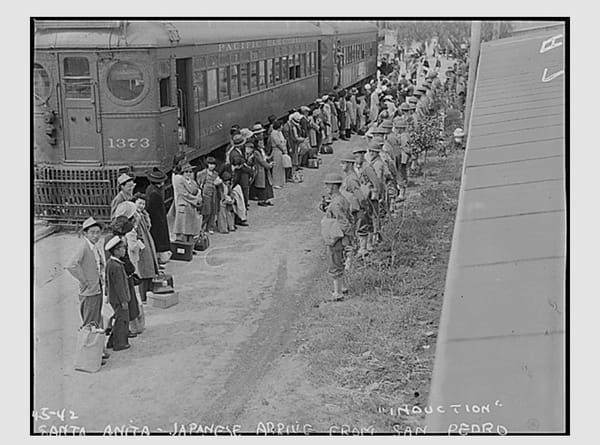Eugenics in the U.S.
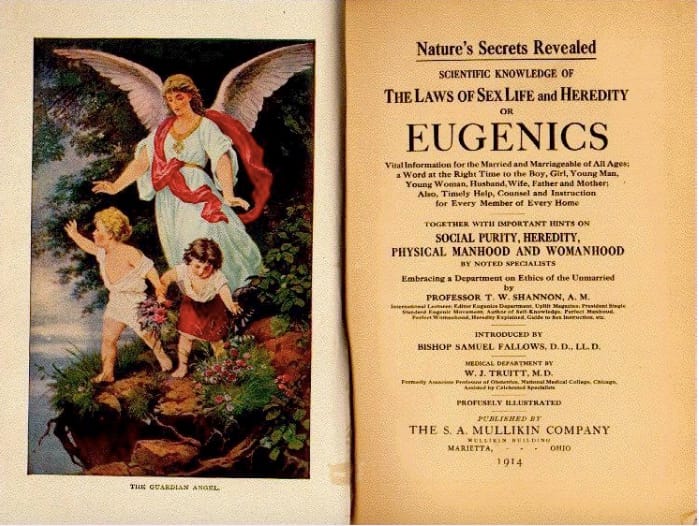
"The past is never dead. In fact, it isn't even past."
William Faulkner, Requiem for a Nun
This is post #12 in my Finding Throughlines project, and it seems like a good time to reiterate what I'm up to here with my Learn, Imagine, Act resource list. With the election of the current regime, I decided I needed a way to stay focused. There were many issues that I felt I needed a better understanding of, in order to take action. I was also in search of ways to imagine both a positive future to work toward, and a range of immediate personal and collective responses to our historical moment. It felt especially important to learn more about the events/movements that have shaped our current situation, so the first items on my list have been materials about race and power.
I'm compiling and sharing my impressions about these materials in order to 1) get more clarity about what we're witnessing, clarity that can then inform creative and political actions, 2) create a record that allows me to both refer back to and expand forward from these sources, and 3) make these materials available to others who are pursuing similar goals.
I must emphasize here: I don't claim to be an expert on any of these topics. In fact, that's the whole point.
The gaps I'm trying to fill in my own education are ones I suspect a lot of us have. My project is just one of many models of how a person might go about that. This also means that when I fall short in my reading choices or my discussion of the issues here, I hope my readers will offer constructive feedback and suggestions.
During the first Trump administration, I began looking for information about eugenics. After doing some initial reading, I felt curious about what the adult population in the U.S. actually knows about eugenics; when/where they learned about it; and how many of their own attitudes have been influenced by it, consciously or not.
I still don't know the answers to those questions. For instance, how many educators have used teachers guides similar to this Canadian one from 2002: https://vhec.org/wp-content/uploads/LUOL-Teachers-Guide.pdf ? Or this timeline from the Anti-Eugenics Collective at Yale:
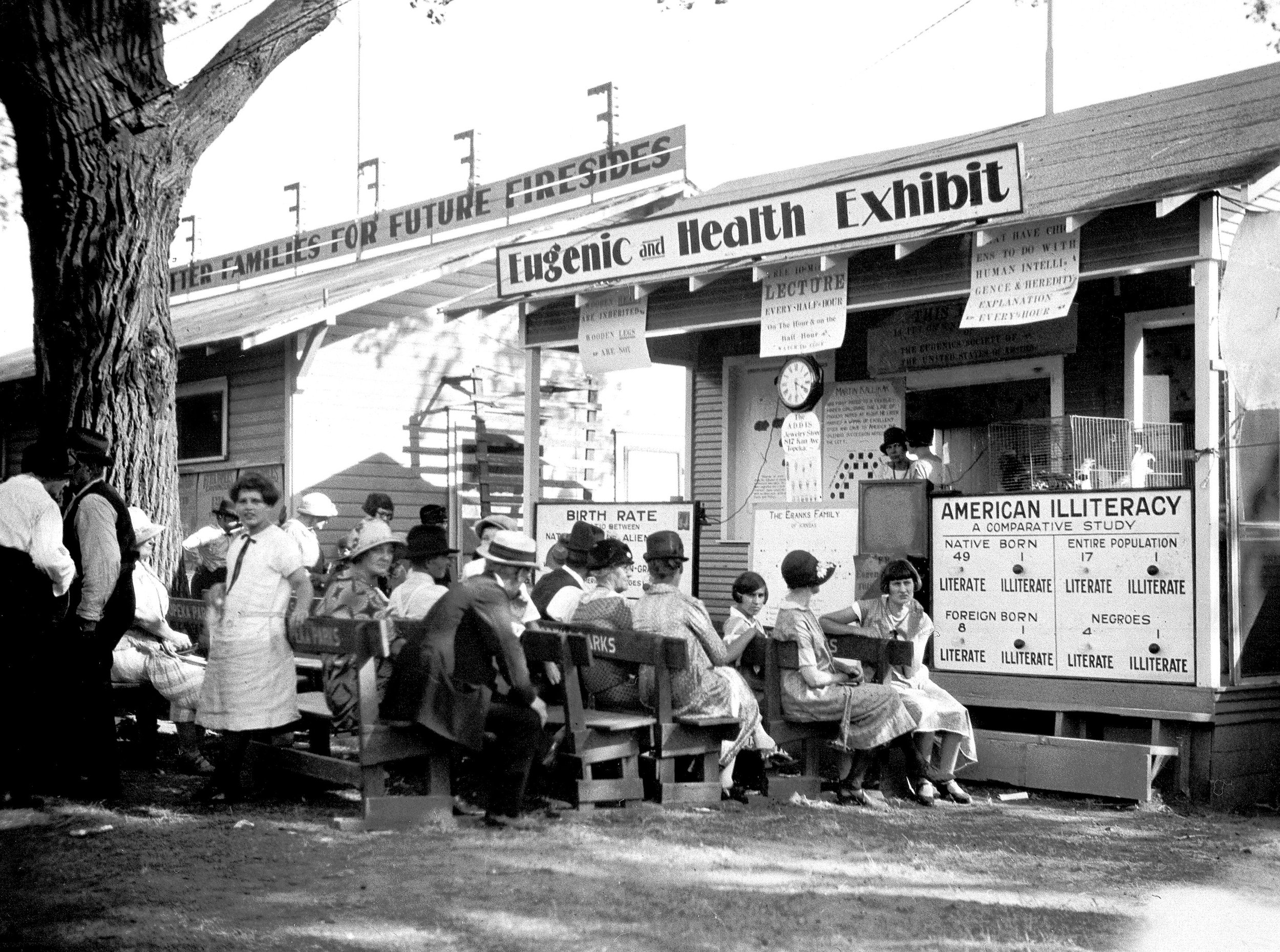
My sense of urgency about our need to reckon with eugenicist beliefs has increased as attacks on people and institutions have escalated—immigrants, people of color, LGBTQIA+, the disabled community, education, public health.
While we may be well-aware of extreme bigotry in this country, I suspect many people are largely unaware of the reach of the historic eugenics movement into our times. Researching this topic has driven home for me, yet again, the truth of that old adage, "the devil is in the details." Often it is only when faced with specifics—hard facts, case examples, and statistics—that I recognize how inadequate my own "general knowledge" is to understanding problems. I'd love to find out that most people are already better educated about this than I was. But I doubt that my previous low level exposure is all that unusual. That's why I hope you will choose at least one of these links to read in full.
Sterilization and Modern Population Engineering
Ruth Ben-Ghiat's article on Fascist population engineering helps put the current incarnations in the U.S. into a broader context. Her summation here is a good starting point for her discussion of the U.S. in the context of far-right manifestations in Italy and Hungary:
"The United States has a long history of using state power to make sure the “wrong” people don’t have babies: the sterilization of at least 60,000 Blacks, Latinos, poor whites, and the disabled during the 20th century speaks to that. So does the prominence of eugenics “science” in America and the history of government-sanctioned racist segregation and violence from California to the Jim Crow South.
America has also been part of an international culture of racism and eugenics. The adaptation of U.S. eugenics programs by the Nazis (who sterilized 400,000 Jews, Afro-Germans, and others, and referred to disabled people targeted for euthanasia as “lives unworthy of life”) is the most famous case."
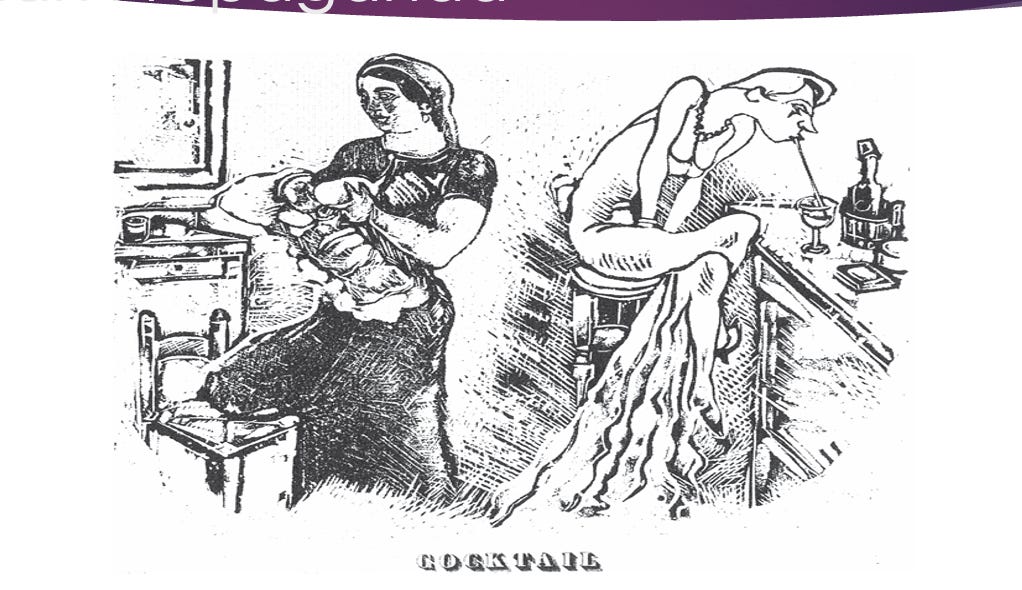
The use of sterilization in the U.S., however, has not been confined to the 20th century, as this history from the Immigration and Human Rights Law blog explains: https://lawblogs.uc.edu/ihrlr/2021/05/28/not-just-ice-forced-sterilization-in-the-united-states/
The prejudices which support such reprehensible actions are still being overtly expressed by people with official governmental roles, as Haley Byrd Wilt reports about Darren Beattie:

"Darren Beattie, the State Department’s acting undersecretary for public diplomacy and public affairs — a senior role that represents American foreign policy to the world — has repeatedly voiced support for mass sterilization of “low-IQ trash.”
'Population control? If only!' he wrote in May 2024. 'Higher quality humans are subsidizing the fertility of lower quality humans.'"
Deadly Ableist Narratives
This notion that there's a group of valuable people who are having to "pay" to support those who are not is being heavily promoted by those now in power. The same administration that clearly disdains expertise, credentials, and other forms of deep training and competence is using expressions of disdain for "low-IQ people" to further stir their grievance culture.
This resentment extends to people with disabilities and chronic illnesses that may require costly medical care. A recent set of posts illustrates how twisted eugenics "logic" translates into cruel and inhumane calculations on an interpersonal level. Here Kelly describes an exchange with a "friend" in which she is told her existence has been "artifically extended," and is somehow a " drain" on the ableist "friend." It is horrifying to consider the toll this is taking, across society, on an already disadvantaged group:
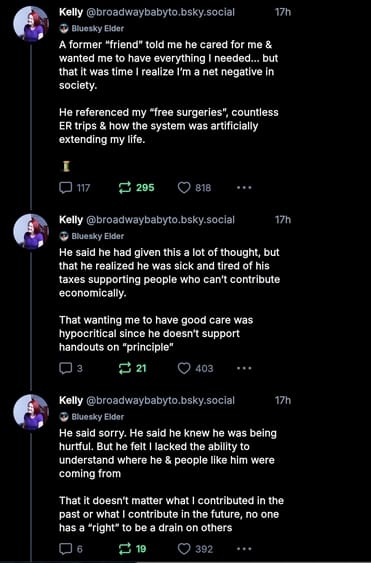
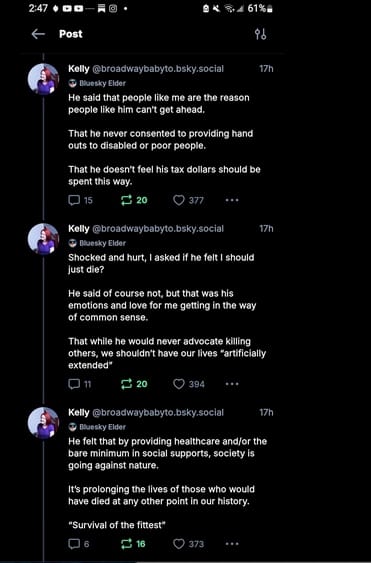
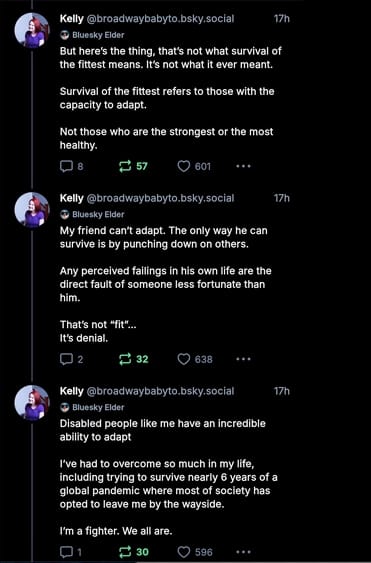
(The original post can be found here on Blue Sky, at https://bsky.app/profile/broadwaybabyto.bsky.social/post/3lqod6mcnpk2v?fbclid=IwY2xjawKum0BleHRuA2FlbQIxMABicmlkETF6bFNNVzRnaXZ3Y1BlSHYzAR5id3OUfEOcFoEgfSIk7nucLn4eGg1ySnR4OnqRtzBZ6KT6kLOGBbadUL9Xlw_aem_0jO39OZx2dKIIRxpirkfiQ)
This kind of argument has long been used against social safety nets and even philanthropy, by those who prefer to believe that some kind of natural order of things should be allowed to cull the herd. Derek Beres' article on "soft eugenics" digs more deeply into the various current forms and historic foundations of this way of conceiving of humans and their right to existence. He looks at how RFK Jr and Elon Musk figure into this picture through their public health and pronatalist beliefs:

Not Just Nazis: 20th Century Adherents, 21st Century Echoes
The following three pieces discuss similar expressions of eugenics-based aggression among 20th century writers and intellectuals. They expose quotes from celebrated British literary figures that are pretty much on a par with Nazi eugenicist extermination policy. A British playwright and theater director, Unwin is also the parent of a profoundly disabled son. His work traces the emergence of eugenics-based values in current British politics and language.
While many assume that the most overt and vicious of these values fell out of favor after the horrors of the Holocaust were revealed, Unwin quotes from AF Tredgold, a British neurologist who, as late as 1952 felt entitled to opine that "many of the defectives are utterly helpless, repulsive in appearance and revolting in their manners. Their existence is a perpetual source of sorrow and unhappiness to their parents, in my opinion it would be an economical and humane procedure were their very existence to be painlessly terminated."
If you read Unwin's articles, you will see similar sentiments expressed by G.B. Shaw, Bertrand Russell, D.H. Lawrence, and Virginia Woolf.
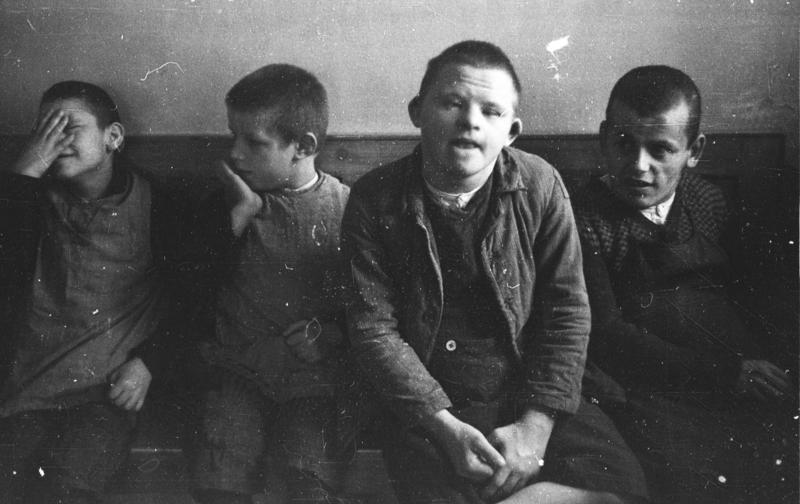


Inculcating the Population

At the Alberta Journal site above, you can find a link to Michael Kohlman's article, "Evangelizing Eugenics." It is a fascinating study of the concerted effort by eugenics organizations to integrate their beliefs into the culture at large over many years.
Kohlman emphasizes the extent to which this was a multi-pronged educational campaign, with support from medical doctors, prestigious university presidents and faculty, preachers and politicians, educators, and others:
In addition to discrete courses, eugenics was often incorporated into introductory biology or “civic biology” courses, meant to influence even larger numbers of the next generation’s business and professional leaders. The American Eugenics Society foresaw this and its Committee on Formal Education espoused the diffusion of eugenics across curriculum, from the elementary school through college levels, and even prescribed an early form of inquiry learning to make instruction more effective . . .
Kohlman's choice of the word "evangelizing" is apt. The fervor with which eugenics was promoted is eye-opening. It was embedded into textbooks, was used to inform immigrant policy, and was reinforced through traveling exhibits and even "Better Baby" contests at state fairs:
"Public exhibitions of eugenics in America followed a popular tradition established in 1915,when the Race Betterment Foundation, headed by John H. Kellogg of breakfast cereal fame,organized an elaborate display at San Francisco’s Panama-Pacific International Exhibition that had millions of visitors. Other organizers included Stanford University chancellor David Starr Jordan and Harvard University president emeritus Charles W. Eliot. The 'exhibit offered a brief for enacting eugenics-based legislation that would support sterilization of defectives and limit immigration to Northern Europeans'(Currell & Cogdell, 2006, p. 362).
Parts of this exhibit were later used by eugenics experts such as Harry H. Laughlin, who testified to “educate” American congressmen on Capitol Hill before the passage of the Johnson-Reed Immigration Restriction Act of 1924. This Act limited hopeful migrants from non-Nordic countries to their pre-1890 levels, greatly favoring the eugenically approved stock from Anglo-Saxon nations. The law was not repealed until 1952 although some provisions persisted to 1965" (Engs, 2005, p. 126).
And finally, here is a PBS documentary that provides an overview of some key cases in U.S. history:
If you are still reading by this point, thank you! It's a tough subject. How much of this were you already aware of? What stands out to you from this collection of resources? What might I be missing? I'd love to hear from you.
Also, if you found this piece helpful and you can help it reach more readers, I would very much appreciate you sharing it. Thanks for being here.












